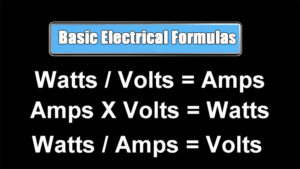rv Education 101
RV Education 101 - Living Comfortably in your RV with 30 Amps
Hi, I’m Mark Polk with “RV Education 101.” Today, I wanna discuss a topic I think is important for all RV owners. That topic is RV living on 30 amps. Typically, RVs come equipped with either a 30-amp electrical system or a 50-amp electrical system. The majority of RVs are equipped with a 30-amp electrical system. Using the 30-amp electrical system in your RV is different than using a 200-amp electrical system in your house. Let me show you what I’m talking about. Before we get started, it’s important to review some very basic electrical formulas. If you understand these formulas you’ll begin to understand why a circuit in your RV or at the campground is overloaded.
 These simple formulas can be used to answer questions based on what information is available. If you have two pieces of information, you can solve any electrical equation dealing with your RV’s electrical system. You already know the RV has a 120-volt electrical system and labels on appliances identify the wattage and/or amperage of the appliance. An example would be attempting to use two 120-volt appliances at the same time that total 2000 watts. The formula is 2000 watts divided by 120 volts equals 16.7 amps, so if both appliances were used on the same 15-amp circuit in the RV, the circuit breaker would trip. Another example would be determining the maximum wattage capacity for an RV with a 30-amp, 120-volt electrical system: 30 amps times 120 volts equals 3600 watts. If you exceed the total 3600-watt capacity, or the total 30-amp capacity, it is highly likely the 30-amp breaker in the RV or the 30-amp breaker at the campground pedestal would trip. You can go one step further by looking at the power distribution center in your RV. You will notice there are several different circuits identified by the individual circuit breakers.
These simple formulas can be used to answer questions based on what information is available. If you have two pieces of information, you can solve any electrical equation dealing with your RV’s electrical system. You already know the RV has a 120-volt electrical system and labels on appliances identify the wattage and/or amperage of the appliance. An example would be attempting to use two 120-volt appliances at the same time that total 2000 watts. The formula is 2000 watts divided by 120 volts equals 16.7 amps, so if both appliances were used on the same 15-amp circuit in the RV, the circuit breaker would trip. Another example would be determining the maximum wattage capacity for an RV with a 30-amp, 120-volt electrical system: 30 amps times 120 volts equals 3600 watts. If you exceed the total 3600-watt capacity, or the total 30-amp capacity, it is highly likely the 30-amp breaker in the RV or the 30-amp breaker at the campground pedestal would trip. You can go one step further by looking at the power distribution center in your RV. You will notice there are several different circuits identified by the individual circuit breakers.
Let’s take a 15-amp circuit, for example: 15 amps times 120 volts equals 1800 watts. A 15 amp circuit that is used solely for electrical outlets in the RV is based on the premise that you will not use all of the outlets on that circuit at the same time or use appliances that will exceed the amperage rating. If, for example, you attempt to use a coffee pot and an induction cooktop at the same time, the 15-amp breaker in the power distribution box will probably trip; here’s why. The combined 16 amps times 120 volts equals 1920 watts, which exceeds the 1800-watt rating of a 15-amp circuit. For devices in the RV that require more amperage, you will notice larger-sized circuit breakers in the power distribution box. For example, the roof air conditioner is on a separate 20-amp circuit breaker. Let’s say your roof air conditioner is drawing 13 amps, you start the microwave and it draws 10 amps, and you put some bread in the toaster, drawing another 8 amps. In this situation, you did not exceed any of the individual circuits in the RV but you did exceed the campground’s 30-amp service, resulting in the 30-amp circuit breaker tripping.
This topic gets a little more complicated when you factor in things like GFCI circuits, the RV power converter that’s used for 12-volt devices, and if there are any wiring-related problems at the campground or in the RV. But if you understand and apply some of these basic formulas, you are well on your way to understanding RV living on 30 amps.

